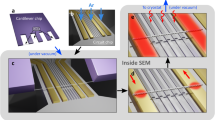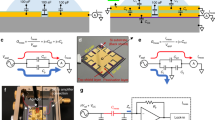Abstract
Single-walled carbon nanotubes offer high sensitivity and very low power consumption when used as field-effect transistors in nanosensors1,2. Suspending nanotubes between pairs of contacts, rather than attaching them to a surface, has many advantages in chemical3, optical4 or displacement1,5 sensing applications, as well as for resonant electromechanical systems6,7. Suspended nanotubes can be integrated into devices after nanotube growth3,5,8,9, but contamination caused by the accompanying additional process steps can change device properties. Ultraclean suspended nanotubes can also be grown between existing device contacts1,4,10,11, but high growth temperatures limit the choice of metals that can be used as contacts. Moreover, when operated in ambient conditions, devices fabricated by either the post- or pre-growth approach typically exhibit gate hysteresis3,8,10,12, which makes device behaviour less reproducible. Here, we report the operation of nanotube transistors in a humid atmosphere without hysteresis. Suspended, individual and ultraclean nanotubes are grown directly between unmetallized device contacts, onto which palladium is then evaporated through self-aligned on-chip shadow masks. This yields pairs of needle-shaped source/drain contacts that have been theoretically shown to allow high nanotube–gate coupling and low gate voltages13. This process paves the way for creating ultrasensitive nanosensors based on pristine suspended nanotubes.
This is a preview of subscription content, access via your institution
Access options
Subscribe to this journal
Receive 12 print issues and online access
$259.00 per year
only $21.58 per issue
Buy this article
- Purchase on Springer Link
- Instant access to full article PDF
Prices may be subject to local taxes which are calculated during checkout




Similar content being viewed by others
References
Franklin, N. R. et al. Integration of suspended carbon nanotube arrays into electronic devices and electromechanical systems. Appl. Phys. Lett. 81, 913–915 (2002).
Kong, J. et al. Nanotube molecular wires as chemical sensors. Science 287, 622–625 (2000).
Helbling, T. et al. Suspended and non-suspended carbon nanotube transistors for NO2 sensing - a qualitative comparison. Phys. Stat. Solidi B 245, 2326–2330 (2008).
Mann, D. et al. Electrically driven thermal light emission from individual single-walled carbon nanotubes. Nature Nanotech. 2, 33–38 (2007).
Stampfer, C. et al. Nano-electromechanical displacement sensing based on single-walled carbon nanotubes. Nano Lett. 6, 1449–1453 (2006).
Sazonova, V. et al. A tunable carbon nanotube electromechanical oscillator. Nature 431, 284–287 (2004).
Jensen, K., Kim, K. & Zettl, A. An atomic-resolution nanomechanical mass sensor. Nature Nanotech. 3, 533–537 (2008).
Nygard, J. & Cobden, D. H. Quantum dots in suspended single-wall carbon nanotubes. Appl. Phys. Lett. 79, 4216–4218 (2001).
Meyer, J. C., Paillet, M. & Roth, S. Single-molecule torsional pendulum. Science 309, 1539–1541 (2005).
Cao, H., Wang, Q., Wang, D. W. & Dai, H. J. Suspended carbon nanotube quantum wires with two gates. Small 1, 138–141 (2005).
Steele, G. A., Gotz, G. & Kouwenhoven, L. P. Tunable few-electron double quantum dots and Klein tunnelling in ultraclean carbon nanotubes. Nature Nanotech. 4, 363–367 (2009).
Kim, W. et al. Hysteresis caused by water molecules in carbon nanotube field-effect transistors. Nano Lett. 3, 193–198 (2003).
Heinze, S. et al. Carbon nanotubes as Schottky barrier transistors. Phys. Rev. Lett. 89, 106801 (2002).
Lin, Y. M., Tsang, J. C., Freitag, M. & Avouris, P. Impact of oxide substrate on electrical and optical properties of carbon nanotube devices. Nanotechnology 18, 295202 (2007).
Sangwan, V. K., Ballarotto, V. W., Fuhrer, M. S. & Williams, E. D. Facile fabrication of suspended as-grown carbon nanotube devices. Appl. Phys. Lett. 93, 113112 (2008).
Wei, X. L., Chen, Q., Xu, S. Y., Peng, L. M. & Zuo, J. M. Beam to string transition of vibrating carbon nanotubes under axial tension. Adv. Funct. Mater. 19, 1753–1758 (2009).
Durrer, L. et al. Narrowing SWNT diameter distribution using size-separated ferritin-based Fe catalysts. Nanotechnology 20, 355601 (2009).
Jungen, A. et al. Synthesis of individual single-walled carbon nanotube bridges controlled by support micromachining. J. Micromech. Microeng. 17, 603–608 (2007).
Javey, A., Guo, J., Wang, Q., Lundstrom, M. & Dai, H. J. Ballistic carbon nanotube field-effect transistors. Nature 424, 654–657 (2003).
Rinkio, M. et al. High-yield of memory elements from carbon nanotube field-effect transistors with atomic layer deposited gate dielectric. New J. Phys. 10, 103019 (2008).
McGill, S. A., Rao, S. G., Manandhar, P., Xiong, P. & Hong, S. High-performance, hysteresis-free carbon nanotube field-effect transistors via directed assembly. Appl. Phys. Lett. 89, 163123 (2006).
Muoth, M. et al. Tilted-view transmission electron microscopy - access for chirality assignment to carbon nanotubes integrated in MEMS. Procedia Chemistry 1, 601–604 (2009).
Datta, S. S., Strachan, D. R. & Johnson, A. T. C. Gate coupling to nanoscale electronics. Phys. Rev. B 79, 205404 (2009).
Vijayaraghavan, A. et al. Charge-injection-induced dynamic screening and origin of hysteresis in field-modulated transport in single-wall carbon nanotubes. Appl. Phys. Lett. 89, 162108 (2006).
Shimauchi, H., Ohno, Y., Kishimoto, S. & Mizutani, T. Suppression of hysteresis in carbon nanotube field-effect transistors: effect of contamination induced by device fabrication process. Jpn J. Appl. Phys. 45, 5501–5503 (2006).
Sung, D. et al. Ab initio study of the effect of water adsorption on the carbon nanotube field-effect transistor. Appl. Phys. Lett. 89, 243110 (2006).
Durrer, L. et al. SWNT growth by CVD on ferritin-based iron catalyst nanoparticles towards CNT sensors. Sens. Actuat. B 132, 485–490 (2008).
Acknowledgements
The authors acknowledge financial support from the Swiss National Science Foundation (SNSF: 200020-121831), ETH Zurich (13/05-3) and Nano-Tera.ch (a program of the Swiss Confederation), as well as general support by the ETH FIRST laboratory team (in particular O. Homan and S. Bellini). The authors thank A. Jungen, B. Burg, C. Stampfer, M. Haluska, M. Mattmann, K. Chikkadi and T. Süss for helpful discussions. TEM was carried out at the Electron Microscopy Facility of ETH Zurich (EMEZ, partially financed by R'Equip), and assistance and support from F. Gramm and P. Tittmann is acknowledged.
Author information
Authors and Affiliations
Contributions
M.M. devised the shadow mask concept and performed the experiments. L.D., T.H. and S.-W.L. contributed to catalyst preparation, electron-beam lithography and SWNT growth. C.R. contributed to discussions and simulations. C.H. initiated the research and contributed to discussions and conclusions. All authors discussed the results and commented on the manuscript.
Corresponding author
Ethics declarations
Competing interests
The authors declare no competing financial interests.
Supplementary information
Supplementary information
Supplementary information (PDF 3033 kb)
Rights and permissions
About this article
Cite this article
Muoth, M., Helbling, T., Durrer, L. et al. Hysteresis-free operation of suspended carbon nanotube transistors. Nature Nanotech 5, 589–592 (2010). https://doi.org/10.1038/nnano.2010.129
Received:
Accepted:
Published:
Issue Date:
DOI: https://doi.org/10.1038/nnano.2010.129
This article is cited by
-
High-speed identification of suspended carbon nanotubes using Raman spectroscopy and deep learning
Microsystems & Nanoengineering (2022)
-
A review of gas sensors based on carbon nanomaterial
Carbon Letters (2022)
-
Observation of Van Hove Singularities and Temperature Dependence of Electrical Characteristics in Suspended Carbon Nanotube Schottky Barrier Transistors
Nano-Micro Letters (2018)
-
Printing Highly Controlled Suspended Carbon Nanotube Network on Micro-patterned Superhydrophobic Flexible Surface
Scientific Reports (2015)



